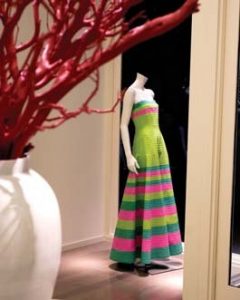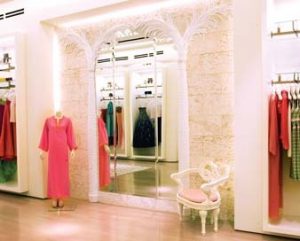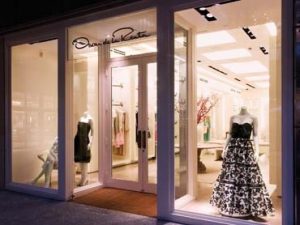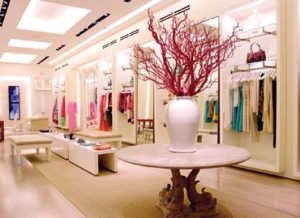Before the boffo success of HBO's “Sex in the City,” no one could have predicted that the quirky actress Sarah Jessica Parker would become the patron saint of American style. Oscar de la Renta was one of the chosen ones. And lo, the septuagenarian designer emeritus, long beloved by first ladies and the ladies-who-lunch, has become a name to get all swoon-y over, again.
With his name now on the radar of the pre-facelift set, his golden years have taken on a solid spin. Planning for the future, he has been grooming the next generation of his own family: his adopted son Moises de la Renta (whose T-shirts made it onto his father's runway), his step-daughter Eliza Reed Bolen (vp of licensing) and her husband Alexander Bolen (ceo).
With this new support, de la Renta's bon vivant nature has blossomed into a lifestyle brand: tableware, candles, bedding, island, city and country furniture collections, rugs, a (lower-priced) O Oscar clothing line, perfume, costumes for the Martha Graham dance company – and his own boutiques.
“In anticipation of expanding internationally,” says Alexander Bolen, “we wanted to open a few of our own establishments to make sure we knew what we were doing before we went to Madrid or Moscow in a big way.” So, for the first time, de la Renta completely controls the presentation of his full collection, without any editing by department store buyers.
Often quoted for his legendary entertaining tips, de la Renta uses these retail outposts to host his shopping guests in elegantly luxe interiors reminiscent of his residences in his native Dominican Republic, New York and Connecticut estate country. The first store (opened last November, designed by New York's Steve Blatz) is on Madison Avenue in Manhattan. The second is the Bal Harbour store in Miami, designed by Meyer Davis Studio (also of New York).
Advertisement
Appropriately, Will Meyer and his partner, Gray Davis, have a background in retail (Davis worked on Armani when at Aero Studios), high-end residential (Meyer had worked on domestic projects at Gwathmey Siegel) and hospitality (South Beach's Abbey Hotel and several high-end bars and restaurants in New York and Las Vegas).
Echoing previous critical assessments of de la Renta's couture, Meyer describes the decor as “both classic and modern at the same time.” However, while de la Renta's flamenco-inspired frocks and sexy caftans are known for their intense Caribbean hues, Meyer says, “Oscar was very clear that the store had to be a classic backdrop to the line, which changes by the season. The basic palette had to be clean and not fight the clothes. He has an understanding of how the clothes' vibrant colors play a prominent role in embellishing the architecture.”
Miami represents an evolution of the inaugural Blatz concept. In New York, the Dominican coral stone walls connote turn-of-the century urban mansions. But in Miami, the distinct stone is used more as a textural accent against bright white modern walls. With the balmy weather, the oversized doors are more likely to be open, welcoming the world with a relaxed resort hotel vibe. Unlike New York, there is more seating in Miami, encouraging loitering time (which harried New Yorkers just fantasize about).
The most distinctive fixtures are from Oscar de la Renta's various furniture lines developed with designer Miles Redd for Century Furniture. Setting the mood from the entrance is a cast-stone dophin table topped by an enormous vase large enough to contain a reef's worth of coral-colored branches. The side chairs and tables all emphasize line and detailing without neglecting comfort.
Down the center of the store is a high-gloss ivory lacquer “catwalk” series of tables that show off this season's crop of accessories. This troop of temptations advances to the back of the store, where life-sized models strut the current collection on flat-screen video monitors. Floor-to-ceiling plantation-style shutters (one for changing room, one for discrete cashwrap) frame this finale with open transoms that psychosomatically convince shoppers of a natural breeze. Brightness in the store energizes and expands the space – from the cerused white oak flooring to the uplit ceilings and illuminated niches.
The key to the cross-generational appeal of the interior is the deft use of elements of mutable associations. A repeated signature from the New York store is the oversized paneled mirror, dramatically framed by plaster palm trees that can connote surfer beaches or Club Med to some customers and magnificent colonial plantations to others. Same trick with the upholstery. Animal prints have been popular since the first caveman came home with his hunting trophy, but in beige and white, zebra feels freshly mod again. And over-the-top baroque furniture that would feel oppressive in dark wood grain become retro hip in painted white.
Advertisement
“At first we didn't know if we would be cannibalizing our department store customer,” concedes Bolen, “and yet it seems that the New York woman who shops at Saks Fifth Avenue is not the one who is cruising up Madison Avenue. Though we're only six months into this, we've substantially exceeded our expectations.” This early success has prompted rapid expansion: By print time, two more stores will be open, in Manhasset's Americana Mall on Long Island and in Las Vegas's Wynn Resort, with sights set on Southern California and Honolulu.
All because Oscar de la Renta's seduction powers now span several generations – from Laura Bush to her party-girl twins to Billy Joel's newest 20-something wife to women sufficiently besotted with his masterful creations to make special trip to his own retail homes.
The store's entrance features a cast-stone dolphin table topped by an
enormous vase, while side chairs and tables all emphasize beautiful detailing,
without neglecting comfort.
Client: Oscar de la Renta, New York
Design and Architect: Meyer Davis Studio, New York
Will Meyer, designer
Gray Davis, designer
Sissy Bishop, project manager
General Contractor: Richter + Ratner Contracting Corp., Maspeth, N.Y.
Advertisement
Outside Design Consultant: Miles Redd, New York (interior design)
Furniture: Century Furniture, Hickory, N.C.
Wallcoverings and Materials: Architectural Sculpture and Restorations Inc., New York
Photography: Bill Wisser, Miami
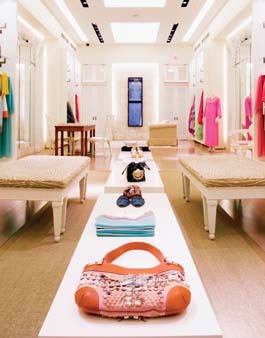

 Headlines2 weeks ago
Headlines2 weeks ago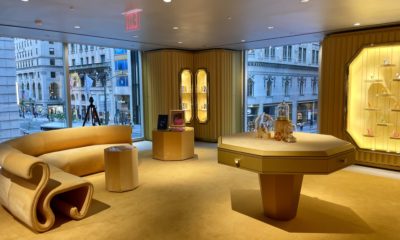
 Eric Feigenbaum7 days ago
Eric Feigenbaum7 days ago
 Headlines5 days ago
Headlines5 days ago
 Headlines1 week ago
Headlines1 week ago
 Headlines2 weeks ago
Headlines2 weeks ago
 Headlines1 week ago
Headlines1 week ago
 Designer Dozen2 weeks ago
Designer Dozen2 weeks ago

